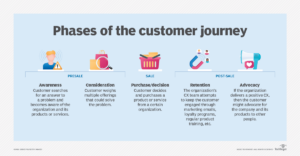How do you measure marketing success? Do you plow forward with what you think will work and hope that your message is reaching and speaking to your audience without stopping to assess your customer journey or track performance? Let’s hope not!
To effectively measure marketing success, it’s best to develop a strategic plan that guides your customer through their entire journey and is based on a solid foundation of marketing metrics and performance assessment.
What is the customer journey?
Before we dive into how to measure marketing success, it’s important to understand that most marketers track performance throughout the customer journey. We’ve talked about the customer journey before, and have defined it as the process of how a person interacts with a brand across various stages of the relationship. There are several versions of customer journey maps, but we like this five-step version shared by TechTarget:
The underlying infrastructure is crucial
As your target audience works its way through the customer journey, your brand should already be set up with the underlying infrastructure needed to measure marketing success (or failure). Marketing campaign effectiveness starts with having all your communication tools in order and integrated. This includes your website, social media pages, physical stores, apps and any other place where you connect with your customers. Once that’s done, the work of tracking and assessment can begin. Here are a few steps that need to take place:
- Set up a data collection system
The first step to measure marketing success is to have an excellent data collection system. Many brands implement a customer relationship management tool (better known as a CRM—we’ll have more on this next month!) which stores and facilitates the use of vital customer data. Depending on the type of CRM chosen, the software can also help slice and dice marketing metrics to provide actionable insights. - Implement onsite tracking tools
Marketing metrics can be collected and tracked using platform-provided resources including Google Analytics (GA4) and Facebook Pixel which are then integrated into the brand’s CRM. When tracking digital marketing KPIs (key performance indicators) throughout the customer journey, onsite tracking tools are essential to measure marketing success. - Build structures for retargeting
Retargeting is a critical strategy when engaging with your target audience throughout the customer journey. Not only is retargeting a big part of demand generation outreach but remarketing in general and even tapping look-alikes (users of a platform that are similar to current customers and followers) are fantastic ways to build customer audiences and remarketing lists. These constant touchpoints can help drive the target audience from the awareness through decision phases of the customer journey, and even into advocacy.
Why segmentation is key
Audience segmentation—breaking up the larger target audience into smaller groups to receive customized marketing messages—is important because customers expect brands to know and understand their needs. This will also allow highly targeted and dialed in messaging to be delivered, increasing the likelihood of the close (purchase). Segmentation can also help brands measure marketing success because it provides another way to filter performance and marketing metrics, giving an even deeper glimpse at what is working and what might need adjustments.
A solid foundation to measure marketing success
By making sure that the underlying infrastructure is established, and then following the three important steps of setting up a data collection system, implementing onsite tracking tools and building structures for retargeting, brands will be able to follow and track marketing metrics throughout the customer journey. Segmenting the audience is a vital approach for a more in-depth look at performance metrics. Brands that use these tactics to set a solid foundation to measure marketing success will benefit from being able to make informed decisions on marketing initiatives.
Connect with the team at Beyond Fifteen to learn how our experts can help your brand develop a strategy to measure marketing success throughout the customer journey.

